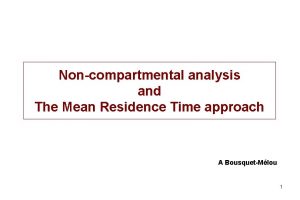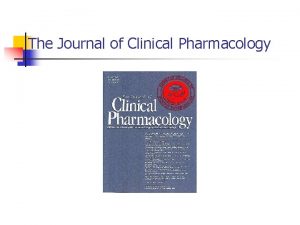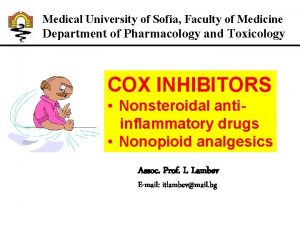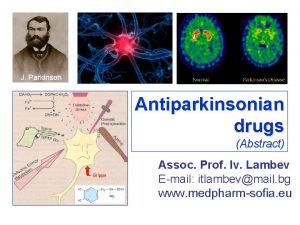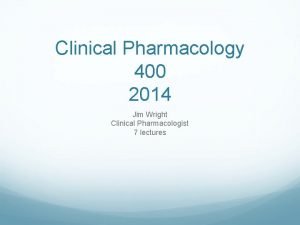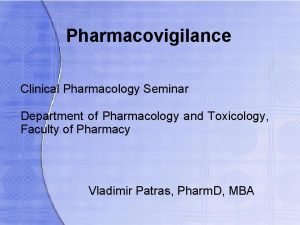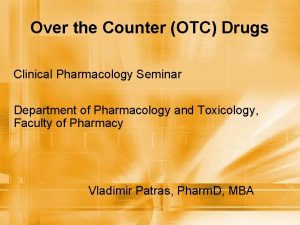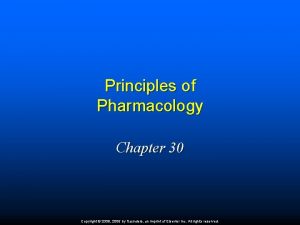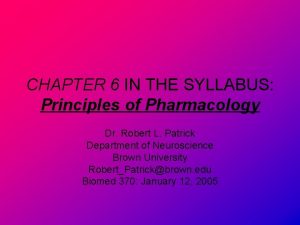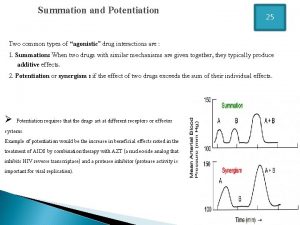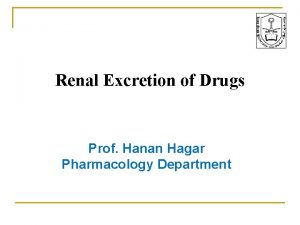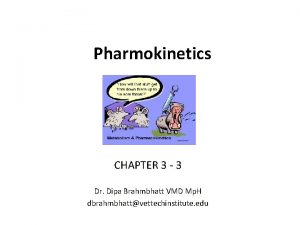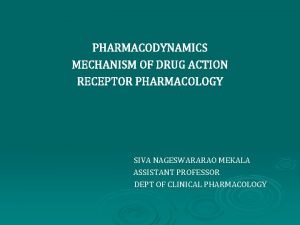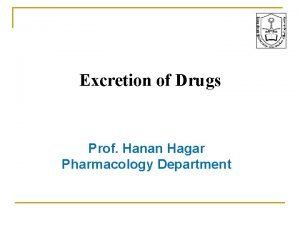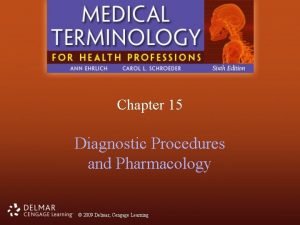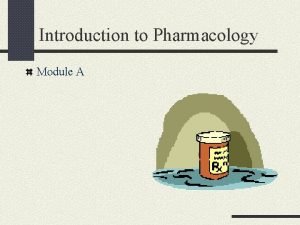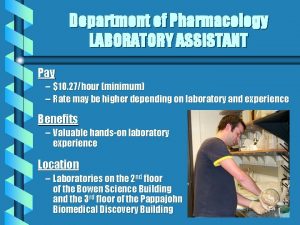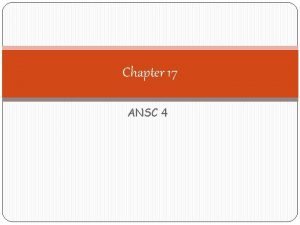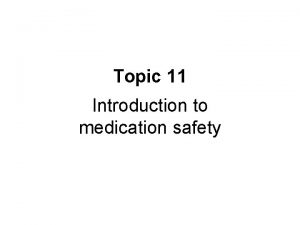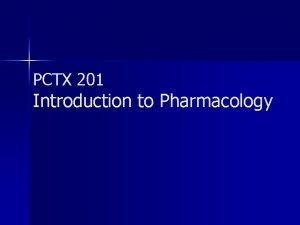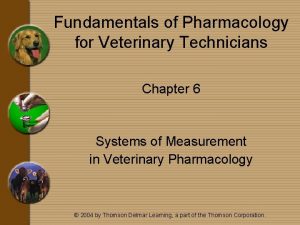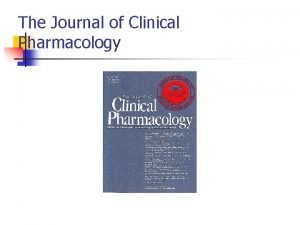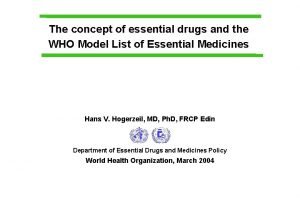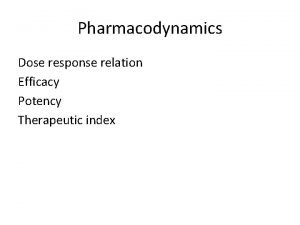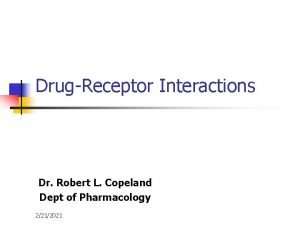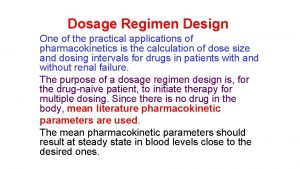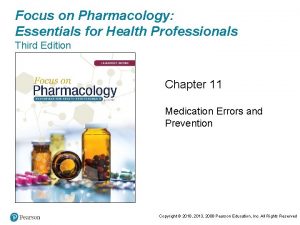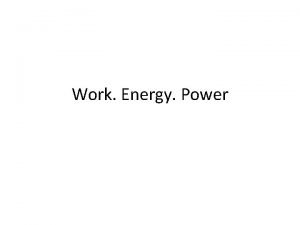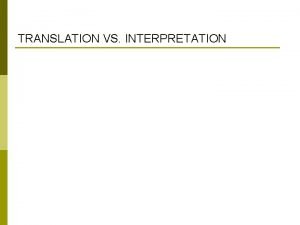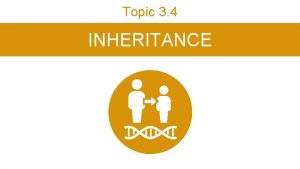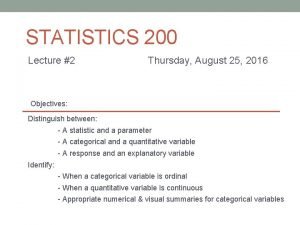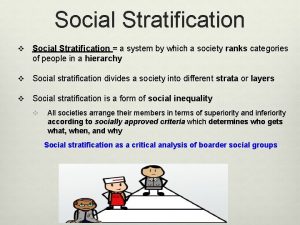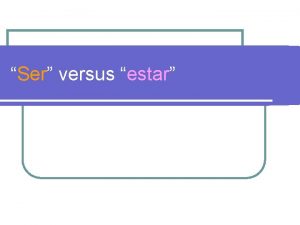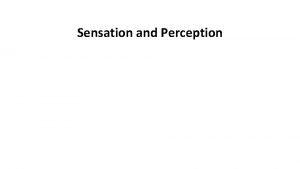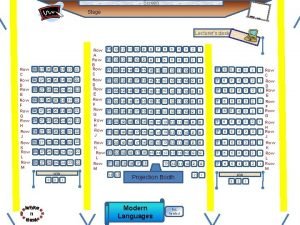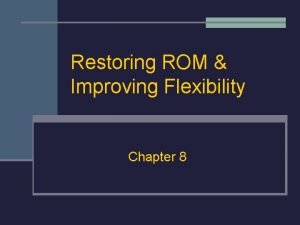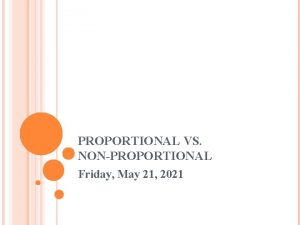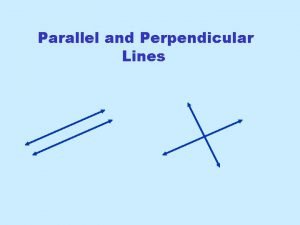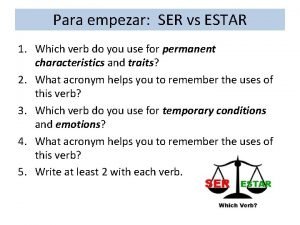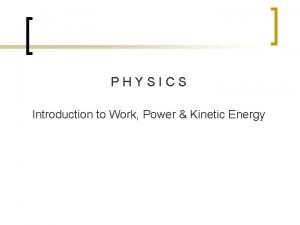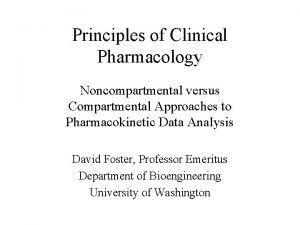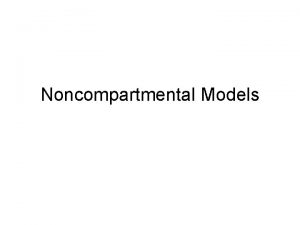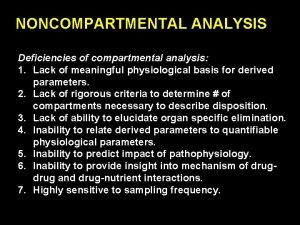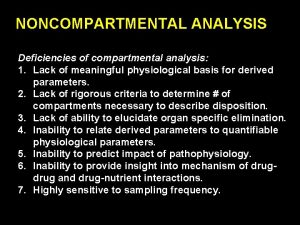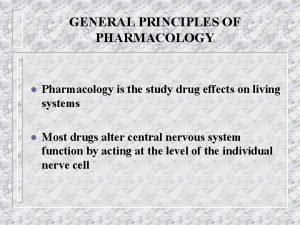Principles of Clinical Pharmacology Noncompartmental versus Compartmental Approaches



























































































- Slides: 91

Principles of Clinical Pharmacology Noncompartmental versus Compartmental Approaches to Pharmacokinetic Data Analysis David Foster, Professor Emeritus Department of Bioengineering University of Washington

Questions asked • What does the body do to the drug? Pharmacokinetics • What does the drug do to the body? Pharmacodynamics • What is the effect of the drug on the body? Disease progression and management • What is the variability in the population? Population pharmacokinetics

What is needed? • A means by which to communicate the answers to the previous questions among individuals with diverse backgrounds • The answer: pharmacokinetic parameters

Pharmacokinetic parameters • Definition of pharmacokinetic parameters • Formulas for the pharmacokinetic parameters • Methods to estimate the parameters from the formulas using data

Pharmacokinetic parameters • Descriptive or observational • Quantitative (requiring a formula and a means to estimate using the formula)

Quantitative parameters • Formula reflective the definition • Data • Estimation methods

Models for estimation • Noncompartmental • Compartmental

Goals of this lecture • Description of the quantitative parameters • Underlying assumptions of noncompartmental and compartmental models • Parameter estimation methods • What to expect from the results

Goals of this lecture • Not to conclude that one method is better than another • What are the assumptions, and how can these affect the conclusions • Make an intelligent choice of methods depending upon what information is required from the data

A drug in the body: constantly undergoing change • • • Absorption Transport in the circulation Transport across membranes Biochemical transformation Elimination

A drug in the body: constantly undergoing change How much? What’s happening? How much?

Kinetics The temporal and spatial distribution of a substance in a system.

Pharmacokinetics The temporal and spatial distribution of a drug (or drugs) in a system.

Definition of kinetics: consequences • Spatial: Where in the system • Temporal: When in the system • If are spatial coordinates and is the measurement of a substance at a specific , then the rate of change of the measurements depends upon and t:

A drug in the body: constantly undergoing change How much? What’s happening? How much?

A drug in the body: constantly undergoing change How much? What’s happening? How much?

Using partial derivatives • Requires a knowledge of physical chemistry, irreversible thermodynamics and circulatory dynamics. • Difficult to solve. • Difficult to design an experiment to estimate parameter values. • While desirable, normally not practical. • Question: What can one do?

Resolving the problem • Reducing the system to a finite number of components • Lumping processes together based upon time, location or a combination of the two • Space is not taken directly into account

Lumped parameter models • Models which make the system discrete through a lumping process thus eliminating the need to deal with partial differential equations. • Classes of such models: – Noncompartmental models (algebraic equations) – Compartmental models (linear or nonlinear differential equations)

The system • Accessible pools: These are pools that are available to the experimentalist for test input and/or measurement. • Nonaccessible pools: These are pools comprising the rest of the system which are not available for test input and/or measurement.

An accessible pool SYSTEM AP

Characteristics of the accessible pool • Kinetically homogeneous • Instantaneous and well-mixed

Kinetic homogeneity

Instantaneous and well-mixed A B S 1 S 2

Instantaneous and well-mixed BRAIN LA RA LV RV S 2 LUNG S 1 S 3 SPLEEN GI LIVER KIDNEY MUSCLE OTHER

The single accessible pool SYSTEM AP E. g. Direct input into plasma with plasma samples.

The two accessible pools SYSTEM AP AP E. g. Oral dosing or plasma and urine samples.

The pharmacokinetic parameters estimated using kinetic data characterize both the kinetics in the accessible pool, and the kinetics in the whole system.

Accessible pool parameters • • Volume of distribution Clearance rate Elimination rate constant Mean residence time

System parameters • • Equivalent volume of distribution System mean residence time Bioavailability Absorption rate constant

Models to estimate the pharmacokinetic parameters The difference between noncompartmental and compartmental models is how the nonaccessible portion of the system is described.

The noncompartmental model

Single accessible pool model SYSTEM AP AP

Two accessible pool model SYSTEM AP AP 1 2

Recirculation-exchange arrow Recirculation/ Exchange AP

Recirculation-exchange arrow Recirculation/ Exchange AP

Single accessible pool model • Parameters (bolus and infusion) • Estimating the parameters from data

Single accessible pool model parameters Bolus Infusion d – dose; u – infusion rate; C(t) – concentration; AUC – area under curve (1 st moment); AUMC – mean area under curve (2 nd moment); – steady state concentration.

What is needed? • Estimates for C(0), and/or • Estimates for AUC and AUMC. . All require extrapolations beyond the time frame of the experiment. Thus this method is not model independent as often claimed.

The integrals

Estimating AUC and AUMC using sums of exponentials Bolus Infusion

Bolus Injection And in addition:

Infusion And in addition:

Estimating AUC and AUMC using other methods • • • Trapezoidal Log-trapezoidal Combinations Other Extrapolating

The Integrals The other methods provide formulas for the integrals between t 1 and tn leaving it up to the researcher to extrapolate to time zero and time infinity.

Trapezoidal rule

Log-trapezoidal rule

Extrapolating from tn to infinity • Terminal decay is a monoexponential often called lz. • Half-life of terminal decay calculated: tz/1/2 = ln(2)/ lz

Extrapolating from tn to infinity From last datum: From last calculated value:

Estimating the Integrals To estimate the integrals, one sums up the individual components.

Advantages of using sums of exponentials • Extrapolation done as part of the data fitting • Statistical information of all parameters calculated • Natural connection with the solution of linear, constant coefficient compartmental models • Software easily available

The Compartmental Model

Single Accessible Pool SYSTEM AP AP

Single Accessible Pool AP AP

A model of the system Accessible Pool Inaccessible Pools INPUT + + A D - C B PLASMA CONCENTRATION SAMPLES TIME Key Concept: Predicting inaccessible features of the system based upon measurements in the accessible pool, while estimating specific parameters of interest.

A model of the system Inaccessible Rooms Accessible Room

Compartmental model • Compartment – instantaneously well-mixed – kinetically homogeneous • Compartmental model – finite number of compartments – specifically connected – specific input and output

Kinetics and the compartmental model Time and Space Time


Notation Fi 0 Qi Fji Fij F 0 i Fij are transport in units mass/time.

The Fij • Describe movement among, into or out of a compartment • A composite of metabolic activity – transport – biochemical transformation – both • Similar time frame

The Fij (ref: see Jacquez and Simon)

The kij are called fractional transfer functions. If a is constant, the kij is called a fractional transfer or rate constant.

Compartmental models and systems of ordinary differential equations • Well mixed: permits writing Qi(t) for the ith compartment. • Kinetic homogeneity: permits connecting compartments via the kij.

The Rate of change of Qi th i compartment Fractional loss of Qi Fractional input from Qj Input from “outside”

Linear, constant coefficient compartmental models • All transfer rates kij are constant. • Assumes “steady state” conditions.

The th i compartment

The compartmental matrix

Compartmental model • A postulation of how one believes a system functions. • The need to perform the same experiment on the model as one did in the laboratory.

Example using SAAM II

Example using SAAM II

Example using SAAM II

Experiments • Need to recreate the laboratory experiment on the model. • Need to specify input and measurements • Key: UNITS

Model of the System? Reality (Data) Conceptualization (Model) Data Analysis and Simulation program optimize begin model … end

A Model of the System Inaccessible Pools Accessible Pool INPUT + + A D - C B PLASMA CONCENTRATION SAMPLES TIME Key Concept: Predicting inaccessible features of the system based upon measurements in the accessible pool, while estimating specific parameters of interest.

Parameter Estimation DATA INPUT PHYSIOLOGICAL SYSTEM MODEL FIT PARAMETER ESTIMATION ALGORITHM PARAMETERS MODEL OUTPUT MATHEMATICAL MODEL 1 2 2 1 3

Parameter estimates • Model parameters: kij and volumes • Pharmacokinetic parameters: volumes, clearance, residence times, etc. • Reparameterization - changing the paramters from kij to the PK parameters.

Recovering the PK parameters from the compartmental model • Parameters based upon the model primary parameters • Parameters based upon the compartmental matrix

Parameters based upon the model primary parameters • Functions of model primary parameters • Clearance = volume * k(0, 1)

Parameters based upon the compartmental matrix Theta, the negative of the inverse of the compartmental matrix, is called the mean residence time matrix.

Parameters based upon the compartmental matrix The average time the drug entering compartment j for the first time spends in compartment i before leaving the system. The probability that a drug particle in compartment j will eventually pass through compartment i before leaving the system.

Compartmental models: advantages • • Can handle non-linearities Provide hypotheses about system structure Can aid in experimental design Can be used to estimate dosing regimens for Phase 1 trials

Noncompartmental versus Compartmental Approaches to PK Analysis: A Example • Bolus injection of 100 mg of a drug into plasma. Serial plasma samples taken for 60 hours. • Analysis using: – Win. Nonlin (“trapezoidal” integration) – Sums of exponentials – Linear compartmental model



Results Win. Nonlin Volume Clearance MRT lz AUC AUMC 1. 02 19. 5 0. 0504 97. 8 1908 Sum of Exponentials Compartmental Model 10. 2 (9%) 1. 02 (2%) 20. 1 (2%). 0458 (3%) 97. 9 (2%) 1964 (3%) 10. 2 (3%) 1. 02 (1%) 20. 1 (1%). 0458 (1%) 97. 9 (1%) 1964 (1%)

Take Home Message • To estimate the traditional pharmacokinetic parameters, either model is probably okay. • Noncompartmental models cannot help in prediction • Best strategy is probably a blend of compartmental to understand “system” and noncompartmental for FDA filings.

Some References • JJ Di. Stefano III. Noncompartmental vs compartmental analysis: some bases for choice. Am J. Physiol. 1982; 243: R 1 -R 6 • DG Covell et. al. Mean Residence Time. Math. Biosci. 1984; 72: 213 -2444 • Jacquez, JA and SP Simon. Qualitative theory of compartmental analysis. SIAM Review 1993; 35: 43 -79 • Jacquez, JA. Compartmental Analysis in Biology and Medicine. Bio. Medware 1996. Ann Arbor, MI. • Cobelli, C, D Foster and G Toffolo. Tracer Kinetics in Biomedical Research. Kluwer Academic/Plenum Publishers. 2000, New York.

SAAM II • A general purpose kinetic analysis software tool • Developed under the aegis of a Resource Facility grant from NIH/NCRR • Available from the SAAM Institute: http: //www. saam. com

Moments • Moments play a key role in estimating pharmacokinetic parameters via noncompartmental models. • Modern use: Yamaoka, K et al. Statistical moments in pharmacokinetics. J. Pharma. Biopharm. 1978; 6: 547 • Initial use: Developed in late 1930’s

Moments
 Mean resistance time
Mean resistance time Clinical pharmacology powered by clinicalkey
Clinical pharmacology powered by clinicalkey Clinical pharmacology
Clinical pharmacology Basic & clinical pharmacology
Basic & clinical pharmacology Dopamine synthesis
Dopamine synthesis Analglesia
Analglesia Clinical pharmacology residency
Clinical pharmacology residency Clinical pharmacology seminar
Clinical pharmacology seminar Clinical pharmacology seminar
Clinical pharmacology seminar Chapter 30 principles of pharmacology
Chapter 30 principles of pharmacology Npte pharmacology
Npte pharmacology Basic principles of pharmacology
Basic principles of pharmacology Venipuncture for radiologic technologists
Venipuncture for radiologic technologists Potentiation pharmacology example
Potentiation pharmacology example First order drug elimination
First order drug elimination What is ion trapping in pharmacology
What is ion trapping in pharmacology Drug metabolism definition
Drug metabolism definition First pass hepatic metabolism
First pass hepatic metabolism Alia drug testing
Alia drug testing What is pharmacology
What is pharmacology First pass effect in pharmacology
First pass effect in pharmacology Receptors in pharmacology
Receptors in pharmacology First pass metabolism definition pharmacology
First pass metabolism definition pharmacology What is pharmacology
What is pharmacology Slidetodoc. com
Slidetodoc. com Competitive antagonist
Competitive antagonist What is ion trapping in pharmacology
What is ion trapping in pharmacology Chapter 15 diagnostic procedures and pharmacology
Chapter 15 diagnostic procedures and pharmacology Pharmacology for nurses: a pathophysiological approach
Pharmacology for nurses: a pathophysiological approach Respiratory pharmacology quiz
Respiratory pharmacology quiz Pharmacology module
Pharmacology module Hepatic extraction ratio
Hepatic extraction ratio Pharmacology of drugs acting on respiratory system
Pharmacology of drugs acting on respiratory system Pharmacology pay
Pharmacology pay Pharmacology definition
Pharmacology definition Toxicology and applied pharmacology
Toxicology and applied pharmacology Rationale meaning in pharmacology
Rationale meaning in pharmacology Pharmacology chapter 1
Pharmacology chapter 1 Pharmacology tutor anderson
Pharmacology tutor anderson Objectives of pharmacology
Objectives of pharmacology Pharmacology for veterinary technicians
Pharmacology for veterinary technicians Annual review of pharmacology and toxicology
Annual review of pharmacology and toxicology Dopamine blockers
Dopamine blockers Define pharmacology
Define pharmacology Concept of essential drugs
Concept of essential drugs Reverse pharmacology
Reverse pharmacology Filtration pharmacology
Filtration pharmacology Loading dose
Loading dose Define bioavailability in pharmacology
Define bioavailability in pharmacology Mechanism of drug action
Mechanism of drug action Efficacy definition pharmacology
Efficacy definition pharmacology Bioavailability of drugs
Bioavailability of drugs Fish pharmacology
Fish pharmacology Define pharmacology
Define pharmacology Maintenance dose
Maintenance dose Maintenance dose formula
Maintenance dose formula Mdi pharmacology
Mdi pharmacology Adrenal drugs pharmacology
Adrenal drugs pharmacology Focus on pharmacology essentials for health professionals
Focus on pharmacology essentials for health professionals Lomotib
Lomotib If time permits quotes
If time permits quotes Tactcardia
Tactcardia Work energy theorem
Work energy theorem Rods versus cones
Rods versus cones Visie versus missie
Visie versus missie Caste system versus class system
Caste system versus class system Direct vs indirect discrimination
Direct vs indirect discrimination Translation versus interpretation
Translation versus interpretation Autosomal dominant vs autosomal recessive
Autosomal dominant vs autosomal recessive Mood vs tone
Mood vs tone Indicative versus subjunctive
Indicative versus subjunctive Response variable
Response variable Religion and conflict theory
Religion and conflict theory Positive correlation versus negative correlation
Positive correlation versus negative correlation The difference between a sign and a symbol
The difference between a sign and a symbol Series vs parallel circut
Series vs parallel circut Ser versus estar
Ser versus estar Top down versus bottom up psychology
Top down versus bottom up psychology Union vs intersection
Union vs intersection Difference between qsar and sar
Difference between qsar and sar Sample fram
Sample fram Active versus passive rom
Active versus passive rom Reliability vs availability
Reliability vs availability Non proportional relationship
Non proportional relationship Positive negative no correlation
Positive negative no correlation Parallel and perpendicular lines slope intercept form
Parallel and perpendicular lines slope intercept form Ser vs estar acronym
Ser vs estar acronym Power versus work
Power versus work High flow versus low flow oxygen
High flow versus low flow oxygen High flow versus low flow oxygen
High flow versus low flow oxygen Trach collar oxygen flow rates
Trach collar oxygen flow rates Ontology epistemology methodology
Ontology epistemology methodology
